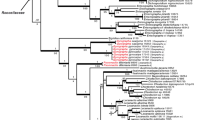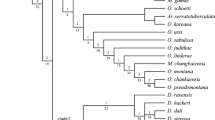Abstract
We investigated phylogenetic relationships of phylum Rotifera using cladistic analysis to uncover all most-parsimonious trees from a data set comprising 60 morphological characters of nine taxa: one Acanthocephala, six Rotifera, and two outgroups (Turbellaria, Gnathostomulida). Analysis of our matrix yielded a single most-parsimonious tree. From our analysis we conclude the following: (1) Class Digononta is paraphyletic; (2) it is still premature to reject rotiferan monophyly; (3) the classification hierarchy that best conforms to this morphologically based, cladistic analysis is similar to several traditional schemes. In spite of these results, it is significant that this analysis yielded a tree that is incongruent with those trees developed from molecular data or by using the principles of evolutionary taxonomy.
Similar content being viewed by others
References
Ahlrichs, W. H., 1997. Epidermal ultrastructure of Seison nebaliae and Seison annulatus, and a comparison of epidermal structures within Gnathifera. Zoomorphology 117: 41–48.
Donoghue, M. J., R. G. Olmstead, J. F. Smith & J. D. Palmer, 1992. Phylogenetic relationships of Dipsacales on RbcL sequences. Ann. MO Bot. Gard. 79: 333–345.
Edmondson, W. T., 1959. Rotifera. In Edmondson, W. T. (ed.), Fresh-Water Biology, 2nd edn. John Wiley, N.Y.: 420–494.
Epp, R. W. & W. M. Lewis, Jr., 1979. Sexual dimorphism in Brachionus plicatilis (Rotifera): evolutionary and adaptive significance. Evolution 33: 919–928.
Faith, D. P. & P. S. Cranston, 1991. Could a cladogram this short have arisen by chance alone? On permutation tests for cladistic structure. Cladistics 7: 1–28.
Garey J. R., T. J. Near, M. R. Nonnemacher & S. A. Nadler, 1996. Molecular evidence for Acanthocephala as a sub-taxon of Rotifera. J. Mol. Evol. 43: 287–292.
Garey J. R., A. Schmidt-Rhaesa, T. J. Near & S. A. Nadler, 1998. The evolutionary relationships of rotifers and acanthocephalans. Hydrobiologia 387/388 (Dev. Hydrobiol. 134): 83–91.
Hillis, D.M., 1991. Discriminating between phylogenetic signal and random noise in DNA sequences. In Miyamoto, M. M. & J. Cracraft (eds), Phylogenetic Analysis of DNA Sequences. Oxford University Press, N.Y.: 278–294.
Kristensen, R. M., 1995. Are Aschelminthes pseudocoelomates or acoelomates? In Lanzavecchia, G., R. Valvassori & M. D. Candia Carnevali (eds), Body Cavities Function and Phylogeny. Selected Symposia and Monographs U.Z.I. 8 Mucchi, Modena: 41–43.
Koste, W., 1978. Rotatoria. Die Rädertiere Mitteleuropas. 2 vols, Gebrüder Borntraeger, Berlin, Stuttgart, Germany.
Lorenzen, S., 1985. Phylogenetic aspects of pseudocoelomate evolution. In Conway Morris, S., J. D. George & H. M. Platt (eds), The Origins and Relationships of Lower Invertebrates. System. Assoc. Volume 28. Clarendon Press, Oxford, U.K.: 210–223.
Maddison W. P. & D. R. Maddison, 1992. MacClade: Analysis of Phylogeny and Character Evolution. Version 3.0. Sinauer Associates, Sunderland.
Markevich, G. I., 1993. Phylogenetic relationships of Rotifera to other veriform taxa. Hydrobiologia 255/256: 521–526.
Melone, G. & C. Ricci, 1995. Rotatory apparatus in bdelloids. Hydrobiologia 313/314: 91–98.
Nielsen, C., 1995. Animal Evolution: Interrelationships of the Living Phyla. Oxford University Press, Oxford.
Nogrady, T., R. L. Wallace & T. W. Snell, 1993. Rotifera. In Dumont, H. J. (ed.), Guides to the Identification of the Microinvertebrates of the Continental Waters of the World, vol. 4. SPB Academic Publishers, The Hague, The Netherlands.
Pennak, R.W., 1989. Fresh-water Invertebrates of the United States, 3rd edn. John Wiley, New York, N.Y., U.S.A.
Ricci, C., 1998. Are lemnisci and proboscis present in the Bdelloidea? Hydrobiologia 387/388 (Dev. Hydrobiol. 134): 93–96.
Rieger, R. M. & S. Tyler, 1995. Sister-group relationship of Gnathostomulida and Rotifera-Acanthocephala. Invertebr. Biol. 114: 186–189.
Swofford, D. L., 1991. PAUP: Phylogenetic analysis using parsimony, Version 3.0s Computer program distributed by the Illinois Natural History Survey, Champaign, IL.
Wallace, R. L. & R. A. Colburn, 1989. Phylogenetic relationships within phylum Rotifera: orders and genus Notholca. Hydrobiologia 186/187: 311–318.
Wallace, R. L., C. Ricci & G. Melone, 1996. A cladistic analysis of pseudocoelomate (aschelminth) morphology. Invertebr. Biol. 115: 104–112.
Wallace, R. L. & T. W. Snell, 1991. Rotifera. In Thorp J. & A. Covich (eds), Ecology and Classifications of North American Freshwater Invertebrates, ch. 8. Academic Press, New York, N.Y.: 187–248.
Author information
Authors and Affiliations
Rights and permissions
About this article
Cite this article
Melone, G., Ricci, C., Segers, H. et al. Phylogenetic relationships of phylum Rotifera with emphasis on the families of Bdelloidea. Hydrobiologia 387, 101–107 (1998). https://doi.org/10.1023/A:1017057619574
Issue Date:
DOI: https://doi.org/10.1023/A:1017057619574




